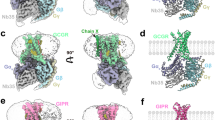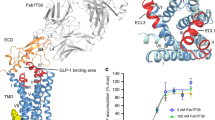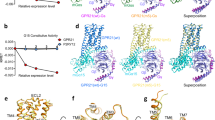Abstract
Glucagon-like peptide 1 (GLP-1) is a hormone with essential roles in regulating insulin secretion, carbohydrate metabolism and appetite. GLP-1 effects are mediated through binding to the GLP-1 receptor (GLP-1R), a class B G-protein-coupled receptor (GPCR) that signals primarily through the stimulatory G protein Gs. Class B GPCRs are important therapeutic targets; however, our understanding of their mechanism of action is limited by the lack of structural information on activated and full-length receptors. Here we report the cryo-electron microscopy structure of the peptide-activated GLP-1R–Gs complex at near atomic resolution. The peptide is clasped between the N-terminal domain and the transmembrane core of the receptor, and further stabilized by extracellular loops. Conformational changes in the transmembrane domain result in a sharp kink in the middle of transmembrane helix 6, which pivots its intracellular half outward to accommodate the α5-helix of the Ras-like domain of Gs. These results provide a structural framework for understanding class B GPCR activation through hormone binding.
This is a preview of subscription content, access via your institution
Access options
Access Nature and 54 other Nature Portfolio journals
Get Nature+, our best-value online-access subscription
$29.99 / 30 days
cancel any time
Subscribe to this journal
Receive 51 print issues and online access
$199.00 per year
only $3.90 per issue
Buy this article
- Purchase on SpringerLink
- Instant access to full article PDF
Prices may be subject to local taxes which are calculated during checkout






Similar content being viewed by others
References
Drucker, D. J. The cardiovascular biology of glucagon-like peptide-1. Cell Metab. 24, 15–30 (2016)
Cho, Y. M., Merchant, C. E. & Kieffer, T. J. Targeting the glucagon receptor family for diabetes and obesity therapy. Pharmacol. Ther. 135, 247–278 (2012)
Lagerström, M. C. & Schiöth, H. B. Structural diversity of G protein-coupled receptors and significance for drug discovery. Nat. Rev. Drug Discov. 7, 339–357 (2008)
Runge, S., Thøgersen, H., Madsen, K., Lau, J. & Rudolph, R. Crystal structure of the ligand-bound glucagon-like peptide-1 receptor extracellular domain. J. Biol. Chem. 283, 11340–11347 (2008)
Underwood, C. R. et al. Crystal structure of glucagon-like peptide-1 in complex with the extracellular domain of the glucagon-like peptide-1 receptor. J. Biol. Chem. 285, 723–730 (2010)
Castro, M., Nikolaev, V. O., Palm, D., Lohse, M. J. & Vilardaga, J. P. Turn-on switch in parathyroid hormone receptor by a two-step parathyroid hormone binding mechanism. Proc. Natl Acad. Sci. USA 102, 16084–16089 (2005)
Culhane, K. J., Liu, Y., Cai, Y. & Yan, E. C. Transmembrane signal transduction by peptide hormones via family B G protein-coupled receptors. Front. Pharmacol. 6, 264 (2015)
Jazayeri, A. et al. Extra-helical binding site of a glucagon receptor antagonist. Nature 533, 274–277 (2016)
Siu, F. Y. et al. Structure of the human glucagon class B G-protein-coupled receptor. Nature 499, 444–449 (2013)
Hollenstein, K. et al. Structure of class B GPCR corticotropin-releasing factor receptor 1. Nature 499, 438–443 (2013)
Yan, C., Wan, R., Bai, R., Huang, G. & Shi, Y. Structure of a yeast step II catalytically activated spliceosome. Science 355, 149–155 (2017)
Bai, X. C. et al. An atomic structure of human γ-secretase. Nature 525, 212–217 (2015)
Peng, W . et al. Structural basis for the gating mechanism of the type 2 ryanodine receptor RyR2. Science 354, aah5324 (2016)
Manglik, A. et al. Structural insights into the dynamic process of β2-adrenergic receptor signaling. Cell 161, 1101–1111 (2015)
Nygaard, R. et al. The dynamic process of β2-adrenergic receptor activation. Cell 152, 532–542 (2013)
Rasmussen, S. G. et al. Crystal structure of the β2 adrenergic receptor-Gs protein complex. Nature 477, 549–555 (2011)
Shukla, A. K. et al. Visualization of arrestin recruitment by a G-protein-coupled receptor. Nature 512, 218–222 (2014)
Peisley, A. & Skiniotis, G. 2D projection analysis of GPCR complexes by negative stain electron microscopy. Methods Mol. Biol. 1335, 29–38 (2015)
Westfield, G. H. et al. Structural flexibility of the Gαs α-helical domain in the β2-adrenoceptor Gs complex. Proc. Natl Acad. Sci. USA 108, 16086–16091 (2011)
Koole, C. et al. Second extracellular loop of human glucagon-like peptide-1 receptor (GLP-1R) has a critical role in GLP-1 peptide binding and receptor activation. J. Biol. Chem. 287, 3642–3658 (2012)
Yang, D. et al. Structural determinants of binding the seven-transmembrane domain of the glucagon-like peptide-1 receptor (GLP-1R). J. Biol. Chem. 291, 12991–13004 (2016)
Coopman, K. et al. Residues within the transmembrane domain of the glucagon-like peptide-1 receptor involved in ligand binding and receptor activation: modelling the ligand-bound receptor. Mol. Endocrinol. 25, 1804–1818 (2011)
Perret, J. et al. Mutational analysis of the glucagon receptor: similarities with the vasoactive intestinal peptide (VIP)/pituitary adenylate cyclase-activating peptide (PACAP)/secretin receptors for recognition of the ligand’s third residue. Biochem. J. 362, 389–394 (2002)
Xiao, Q., Jeng, W. & Wheeler, M. B. Characterization of glucagon-like peptide-1 receptor-binding determinants. J. Mol. Endocrinol. 25, 321–335 (2000)
Wootten, D., Simms, J., Miller, L. J., Christopoulos, A. & Sexton, P. M. Polar transmembrane interactions drive formation of ligand-specific and signal pathway-biased family B G protein-coupled receptor conformations. Proc. Natl Acad. Sci. USA 110, 5211–5216 (2013)
Yaqub, T. et al. Identification of determinants of glucose-dependent insulinotropic polypeptide receptor that interact with N-terminal biologically active region of the natural ligand. Mol. Pharmacol. 77, 547–558 (2010)
Di Paolo, E. et al. Contribution of the second transmembrane helix of the secretin receptor to the positioning of secretin. FEBS Lett. 424, 207–210 (1998)
Dods, R. L. & Donnelly, D. The peptide agonist-binding site of the glucagon-like peptide-1 (GLP-1) receptor based on site-directed mutagenesis and knowledge-based modelling. Biosci. Rep. 36, e00285 (2015)
Wootten, D. et al. The extracellular surface of the GLP-1 receptor is a molecular trigger for biased agonism. Cell 165, 1632–1643 (2016)
Roberts, D. J., Vertongen, P. & Waelbroeck, M. Analysis of the glucagon receptor first extracellular loop by the substituted cysteine accessibility method. Peptides 32, 1593–1599 (2011)
Barwell, J., Conner, A. & Poyner, D. R. Extracellular loops 1 and 3 and their associated transmembrane regions of the calcitonin receptor-like receptor are needed for CGRP receptor function. Biochim. Biophys. Acta 1813, 1906–1916 (2011)
Yang, L. et al. Conformational states of the full-length glucagon receptor. Nat. Commun. 6, 7859 (2015)
Parthier, C., Reedtz-Runge, S., Rudolph, R. & Stubbs, M. T. Passing the baton in class B GPCRs: peptide hormone activation via helix induction? Trends Biochem. Sci. 34, 303–310 (2009)
Donnelly, D. The structure and function of the glucagon-like peptide-1 receptor and its ligands. Br. J. Pharmacol. 166, 27–41 (2012)
Ballesteros, J. A & Weinstein, H. in Methods in Neuroscience Vol. 25 (ed. Sealfon, S. C. ) Ch. 19 (Elsevier, 1995)
Fredriksson, R., Lagerström, M. C., Lundin, L. G. & Schiöth, H. B. The G-protein-coupled receptors in the human genome form five main families. Phylogenetic analysis, paralogon groups, and fingerprints. Mol. Pharmacol. 63, 1256–1272 (2003)
Bailey, R. J. & Hay, D. L. Agonist-dependent consequences of proline to alanine substitution in the transmembrane helices of the calcitonin receptor. Br. J. Pharmacol. 151, 678–687 (2007)
Conner, A. C. et al. A key role for transmembrane prolines in calcitonin receptor-like receptor agonist binding and signalling: implications for family B G-protein-coupled receptors. Mol. Pharmacol. 67, 20–31 (2005)
Rasmussen, S. G. et al. Crystal structure of the human β2 adrenergic G-protein-coupled receptor. Nature 450, 383–387 (2007)
Hjorth, S. A., Orskov, C. & Schwartz, T. W. Constitutive activity of glucagon receptor mutants. Mol. Endocrinol. 12, 78–86 (1998)
Schipani, E., Kruse, K. & Jüppner, H. A constitutively active mutant PTH-PTHrP receptor in Jansen-type metaphyseal chondrodysplasia. Science 268, 98–100 (1995)
Wootten, D. et al. Key interactions by conserved polar amino acids located at the transmembrane helical boundaries in Class B GPCRs modulate activation, effector specificity and biased signalling in the glucagon-like peptide-1 receptor. Biochem. Pharmacol. 118, 68–87 (2016)
Venkatakrishnan, A. J. et al. Diverse activation pathways in class A GPCRs converge near the G-protein-coupling region. Nature 536, 484–487 (2016)
Zheng, S. Q. et al. MotionCor2: anisotropic correction of beam-induced motion for improved cryo-electron microscopy. Nat. Methods 14, 331–332 (2017)
Rohou, A. & Grigorieff, N. CTFFIND4: fast and accurate defocus estimation from electron micrographs. J. Struct. Biol. 192, 216–221 (2015)
Scheres, S. H. RELION: implementation of a Bayesian approach to cryo-EM structure determination. J. Struct. Biol. 180, 519–530 (2012)
Scheres, S. H. Semi-automated selection of cryo-EM particles in RELION-1.3. J. Struct. Biol. 189, 114–122 (2015)
Scheres, S. H. Processing of structurally heterogeneous cryo-EM data in RELION. Methods Enzymol. 579, 125–157 (2016)
Penczek, P. A., Grassucci, R. A. & Frank, J. The ribosome at improved resolution: new techniques for merging and orientation refinement in 3D cryo-electron microscopy of biological particles. Ultramicroscopy 53, 251–270 (1994)
Kucukelbir, A., Sigworth, F. J. & Tagare, H. D. Quantifying the local resolution of cryo-EM density maps. Nat. Methods 11, 63–65 (2014)
Yang, J. et al. The I-TASSER Suite: protein structure and function prediction. Nat. Methods 12, 7–8 (2015)
Pettersen, E. F. et al. UCSF Chimera–a visualization system for exploratory research and analysis. J. Comput. Chem. 25, 1605–1612 (2004)
Emsley, P. & Cowtan, K. Coot: model-building tools for molecular graphics. Acta Crystallogr. D Biol. Crystallogr. 60, 2126–2132 (2004)
Wang, R. Y. et al. Automated structure refinement of macromolecular assemblies from cryo-EM maps using Rosetta. eLife 5, e17219 (2016)
Adams, P. D. et al. PHENIX: a comprehensive Python-based system for macromolecular structure solution. Acta Crystallogr. D Biol. Crystallogr. 66, 213–221 (2010)
Acknowledgements
We thank M. Su for support with electron microscopy, W. Weis for comments on model refinement, and S. Reedtz-Runge, T. Egebjerg and N. Kulahin for suggesting the rabbit GLP-1R as a candidate for structural studies. This work was supported by NIH grants DK090165 and NS092695 (to G.S.) and R44 DK106942 (to ConfometRx).
Author information
Authors and Affiliations
Contributions
Y.Z. performed cryo-EM map calculation, model building and refinement; B.S. established GLP-1–GLP-1R–Gs complex formation strategy; B.S., D.F. and M.C. expressed and purified the complex; S.L. prepared Gs protein; H.H., Q.Q., Y.Z. acquired cryo-EM data; J.T.T. assisted in specimen screening by negative-stain EM; Y.Z., B.K.K. and G.S. analysed the data and wrote the manuscript; T.S.K, B.K.K. and G.S. supervised the project.
Corresponding authors
Ethics declarations
Competing interests
The authors declare no competing financial interests.
Additional information
Reviewer Information Nature thanks R. Glaeser, D. Poyner and T. Schwartz for their contribution to the peer review of this work.
Publisher's note: Springer Nature remains neutral with regard to jurisdictional claims in published maps and institutional affiliations.
Extended data figures and tables
Extended Data Figure 1 Purification of the hGLP-1–rGLP-1R–Gs complex.
Size-exclusion chromatography profile and corresponding SDS–PAGE gel of the purified hGLP-1–rGLP-1R–Gs complex (‘h’ indicates human and ‘r’ indicates rabbit homologue).
Extended Data Figure 2 Cryo-EM micrograph and 2D class averages of the hGLP-1–rGLP-1R–Gs complex.
a, Cryo-EM micrograph of the activated GLP-1R–Gs complex. Examples of particle projections are circled. Scale bar, 30 nm. b, Representative reference-free two-dimensional averages show distinct secondary structure features for G protein and GLP-1R embedded in MNG detergent micelle. The diameter of the circular windows is 17 nm.
Extended Data Figure 3 Single-particle cryo-EM analysis of the hGLP-1–rGLP-1R–Gs complex.
Flow chart of cryo-EM data processing of the hGLP-1–rGLP-1R–Gs complex, including particle projection selection, classification and 3D density map reconstruction, related to Fig. 1. Details are provided in the Methods section.
Extended Data Figure 4 Resolution of cryo-EM map and validation of the hGLP-1–rGLP-1R–Gs structure.
a, Resolution estimation of the EM map. Gold standard Fourier shell correlation (FSC) curves, showing the overall nominal resolution at 4.1 Å (blue) and 3.9 Å (red) on the stable region including hGLP-1, transmembrane domain and the α5-helix the Gαs Ras-like domain. b, FSC curves of the final refined model versus the final cryo-EM map (full dataset, black), of the outcome of model refinement with a half map versus the same map (red), and of the outcome of model refinement with a half map versus the other half map (green). c, Final three-dimensional density map coloured according to local resolution.
Extended Data Figure 5 A near-atomic resolution model of the hGLP-1–rGLP-1R–Gs complex.
EM density map and model are shown for all seven transmembrane α-helices and helix 8 of rGLP-1R, hGLP-1 peptide and the α5-helix of the Gαs Ras-like domain. Bulky resides are indicated for each segment. The C-terminal half of TM6 exhibits relatively poor density, reflecting its intrinsic flexibility.
Extended Data Figure 6 Features of cryo-EM map before density subtraction.
a, GLP-1R–Gs complex structure docked into cryo-EM density map before micelle density subtraction. Arrows indicate the density corresponding to the linker between the NTD and transmembrane bundle, and Gβγ lipid moiety inserting into the detergent micelle. b, Close-up view in this map shows density connecting helix 8 and Gβ at the position of R419 of helix 8 and G310–H311 of Gβ. Model is coloured as in Fig. 1c.
Extended Data Figure 7 Conformation of ECL2 in class B GPCRs.
a, Close-up view of R299 of ECL2 modelled into the density map at low threshold shows that the Arg side chain reaches into the GLP-1 binding pocket in close proximity to H7 and T11 of the peptide. b, Top-down view of structural overlay of the active GLP-1R transmembrane domain and the inactive CRF1R transmembrane domain (PDB code: 4K5Y) indicates the conformational similarity of ECL2 in the two structures. Detailed views of boxed regions show that W297 and R299 in the active GLP-1R structure adopt similar orientations compared to the equivalent residues in CRF1R. The model of the GLP-1R complex is coloured as in Fig. 1c. CRF1R is coloured purple.
Extended Data Figure 8 Structures of class B GPCR ligands bound to NTDs.
a, Close-up view of structural superposition of the cryo-EM structure of GLP-1–GLP-1R onto crystal structures of N-terminal domain of GLP-1R in complex with peptide exendin-4 (blue; a peptide approved for clinical use) and GLP-1 (purple), respectively. The model of hGLP-1–rGLP-1R–Gs is coloured as in Fig. 1. b, Structural superposition of the cryo-EM structure of GLP-1R NTD bound to GLP-1 to crystal structures of GIPR NTD bound to GIP (blue) and PTH1R NTD bound to PTH (cyan). a, b, Residues S14, S17, S18, F28 and W31 of GLP-1 and equivalent residues in the other peptides are shown in ball and stick (right panel only), highlighting that the corresponding side chains adopt a similar conformation in all available structures. c, Structure-based alignment of selected class B GPCR peptide ligand sequences.
Extended Data Figure 9 Potential NTD–transmembrane bundle interaction, orthosteric agonist binding pocket in GLP-1R and β2AR.
a, Close-up view of the model docked into cryo-EM density map (grey) on the region of NTD–transmembrane bundle interation at low threshold shows the potential hydrogen bond between Q213 of ECL1 and R40 of the NTD α1-helix. b, Overlay of GPCR transmembrane bundles in the activated GLP-1R complex and T4L-β2AR–Gs–Nb35 complex shown in light green and grey, respectively. Cut-through view showing that the GLP-1 peptide N-terminal H7 (orange ball and stick) reaches the same level as the orthosteric agonist BI-167107 (yellow).
Extended Data Figure 10 Comparison of G protein trimer structures from activated GLP-1R–Gs–Nb35 complex and T4L-β2AR–Gs–Nb35 complex with alignment on Gαs Ras-like domain alone, related to Fig. 5.
a, Views of superposition of G protein trimer structures from the activated GLP-1R–Gs structure (Gαs Ras-like domain in gold, Gβ in light blue, Gγ in dark blue) and T4L-β2AR–Gs structure (all coloured in grey). b–d, Schematic representation (b) of recognition between the C terminus of α5-helix (H387–L394) and active receptors of β2AR (c) and GLP-1R (d). The sequence of the C terminus of α5-helix (H387–L394) is shown in the middle in gold. Residues involved in the interaction with α5-helix (H387–L394) in the receptor of β2AR (green box) and GLP-1R (purple box) are shown above and below the schematic, respectively. Hydrophobic interactions are shown in blue and polar interactions in red. Ballesteros–Weinstein numbering in superscript is shown.
Supplementary information
Supplementary Information
This file contains Supplementary Tables 1-2, Supplementary Figure 1 and Supplementary References. (PDF 6468 kb)
Rights and permissions
About this article
Cite this article
Zhang, Y., Sun, B., Feng, D. et al. Cryo-EM structure of the activated GLP-1 receptor in complex with a G protein. Nature 546, 248–253 (2017). https://doi.org/10.1038/nature22394
Received:
Accepted:
Published:
Issue Date:
DOI: https://doi.org/10.1038/nature22394



